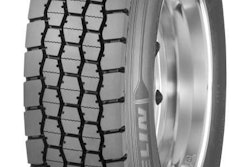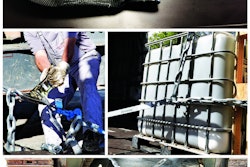
Pressure Basics
Bendix says while a low-pressure tire can be pretty easy to spot on a standard car, the more robust engineering of commercial truck tires and the arrangement of dual-tire wheel-ends make it more difficult to visibly notice underinflation. And it doesn’t take much less air in a tire to have significant negative impact: Bendix says tire underinflation by as little as 10 percent results in a 1.5 percent drop in fuel economy, and underinflation by 20 percent results in a 30 percent reduction in tire life.
“Not many folks can tell at a glance the difference between a truck tire that’s running a bit low at 95 psi and one inflated properly at 105 psi – but that’s all it takes to start accelerating wear,” says Jon Intagliata, product manager for Tire Pressure Monitoring Systems (TPMS) at Bendix. “Add in the fact that safety components – ranging from brakes to stability and collision mitigation systems – can’t perform to their optimal capabilities if tires are not operating in their proper condition, and the stakes become even greater.”
Bendix highly recommends the use of a tire pressure monitoring system (TPMS) to provide fleets and drivers with real-time information and alerts, enabling them to address potential failures before they occur.
The Issue of Imbalance
A dual-tire arrangement does require additional care in that close attention be paid to keeping both tires inflated to the same pressure. Bendix says if the pressure between both tires is not equal, one tire will wind up carrying a greater share of the load and do more work than the other. In addition, their sizes will be slightly different and as the tire assembly rotates, the smaller tire will drag, causing premature wear. In short, running imbalanced duals increases the odds of a blowout on the overloaded tire and significantly shortens tire life on the underinflated tire, Bendix says. Industry data has shown that the pressure difference at which this becomes an issue can be as little as 5 psi. This small difference in pressure creates a difference in the tire’s circumference and causes the smaller tire to be dragged by the larger tire, producing accelerated or irregular wear, the company adds.
While addressing dual-tire imbalance is simple enough–it’s just a matter of setting the tires to the right pressure, which is routine maintenance–noticing it in the first place can be trickier. Bendix claims this is especially true for the inner dual which is masked by the outer tire, making it very difficult to spot a problem.
The best tool for tracking proper tire psi is a tire pressure monitoring system. Bendix writes these vary in design but operate in the same general fashion, using sensors mounted at each wheel-end of a tractor or trailer to constantly measure a tire’s pressure. If the sensor is mounted inside the tire, it can also measure temperature. (Checking tires only when they are cool is not always convenient or feasible, and temperature compensation is important to ensure that tire pressure is able to be monitored over a long trip.) Tire pressure and temperature information is transmitted wirelessly and displayed on either an in-cab display or a technician’s handheld device during maintenance checks, the company says.
In the cab, most TPMS systems will provide pressure alerts to drivers. Some, like the SmarTire TPMS by Bendix CVS, can provide temperature-compensated pressure figures, along with high-temperature alerts. Bendix says SmarTire also includes a programmable alert that will let the driver or a technician know when a set of duals exceeds a set deviation in pressure between the two tires. To monitor trailers, SmarTire Trailer-Link TPMS wirelessly transmits alerts, pressure, and temperature information for trailers directly to the tractor and is displayed on the SmarTireTPMS dash gauge or integrated vehicle cluster, the company says.
“The more real-time information and alerts a system can provide, the better equipped a driver is out on the road, and the safer the truck becomes,” Intagliata says. “A steel-belted truck tire blowout can do damage on several levels, from harming wheel-end components to vehicle downtime to causing an accident. Simply paying attention to the details of correct inflation, tire temperature, and dual-tire pressure balance can help keep vehicles on the road and in good operating condition, reducing the odds of a catastrophic failure, and improving highway safety.”











